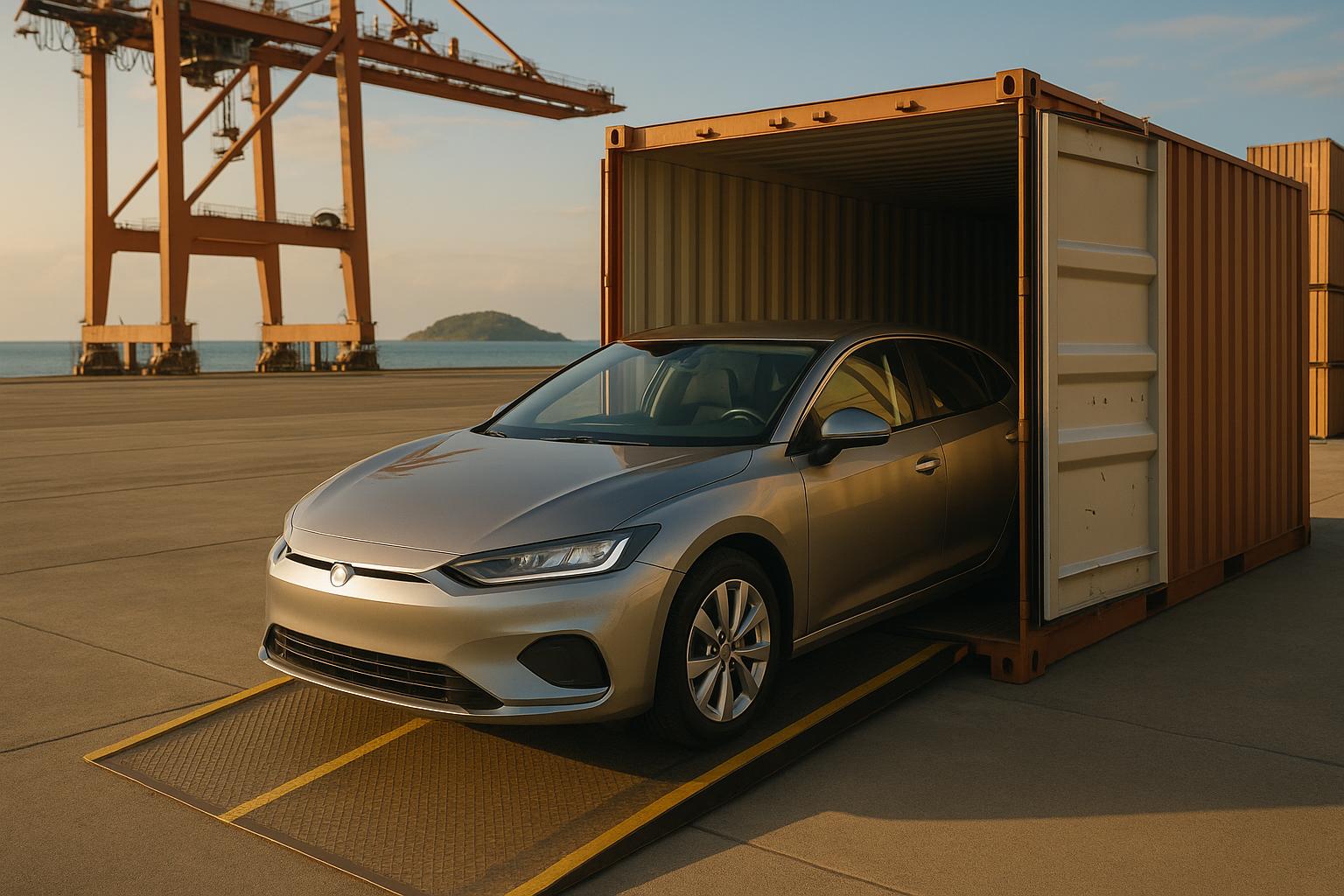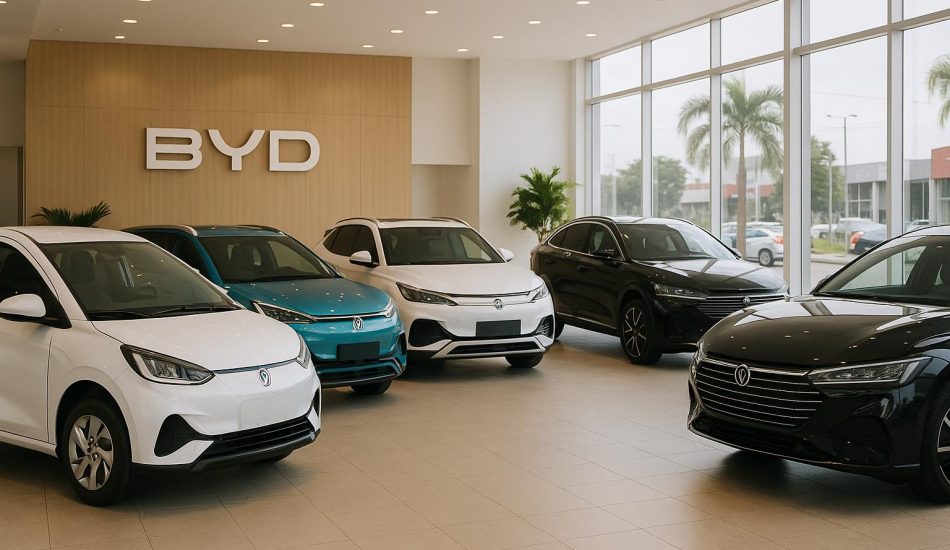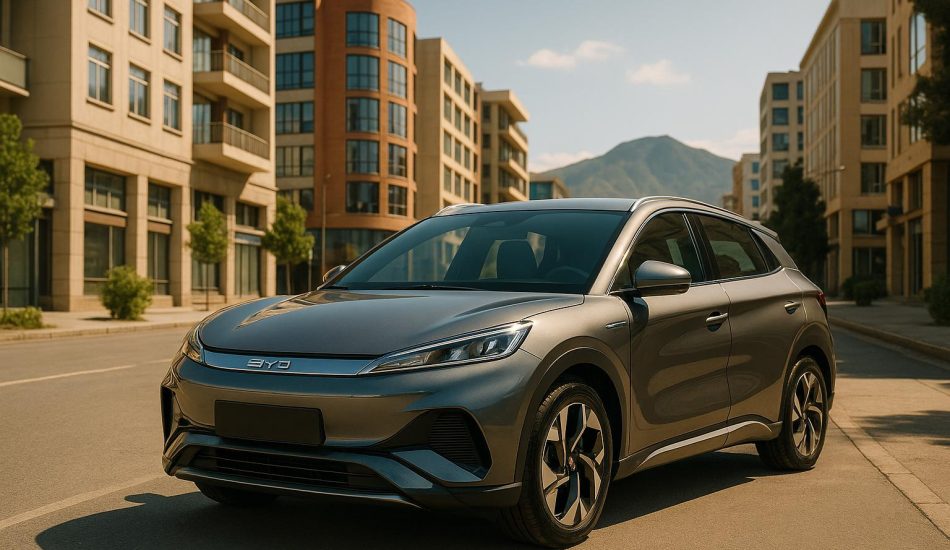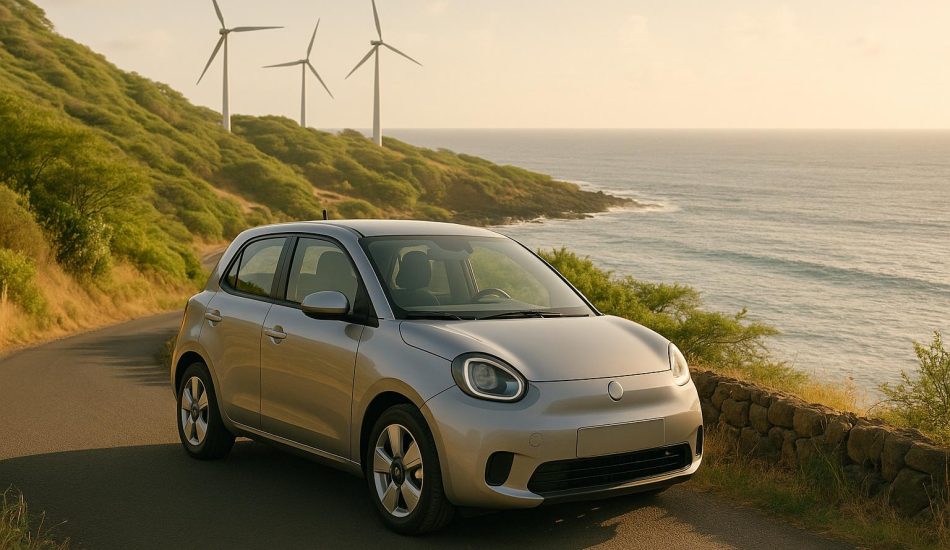
To import an electric vehicle (EV) into Comoros in 2025, you need to follow specific rules and prepare detailed documentation. Here’s a quick summary:
- Only left-hand drive EVs are allowed in Comoros.
- Required documents include customs declarations, supplier invoices, bills of lading, proof of residency, and payment receipts for duties and taxes.
- Customs clearance is processed at the Port of Moroni using the ASYCUDA system.
- EVs must meet strict technical and safety standards, especially for battery compliance.
- Import costs are calculated using the CIF method (Cost, Insurance, and Freight), which includes tariffs and VAT.
- Public charging infrastructure is limited, so a reliable home charging setup is essential.
Key Challenges: Errors in paperwork or non-compliance with regulations can lead to delays or additional fees. Partnering with experienced customs brokers can help streamline the process.
Comoros EV Import Rules and Requirements
2025 Import Laws Overview
Starting in 2025, Comoros will allow the import of only left-hand drive electric vehicles (EVs). This applies to both passenger cars and light commercial vehicles. While the government is actively promoting EV adoption, tax incentives are still in the early stages of development. Imports must comply with Incoterms and are processed through the Port of Moroni.
Vehicle Requirements
To be approved for import, all EVs must adhere to specific technical and safety standards outlined by the regulations. These requirements ensure that vehicles meet the necessary criteria for operation in Comoros.
Required Documents and Compliance
Required Import Documents
To ensure a smooth import process for your EV, you’ll need to keep essential documents on hand for at least three years. These records establish your vehicle’s legitimacy, value, origin, and compliance with regulations.
Start with a customs declaration in the electronic ASYCUDA format, issued by an authorized customs broker. For shipping, include the original bill of lading for sea freight or an Air Transport Letter (ATL) for air freight, along with a delivery note.
You’ll also need a supplier invoice that outlines the purchase price, specifications, and transaction details. Pair this with a freight bill and packing list to confirm shipping costs.
For EV-specific requirements, prepare your vehicle title and registration, proof of ownership, and current insurance documents. On the personal side, provide your passport, driver’s license, and proof of residency in Comoros. Don’t forget the receipt of payment for duties and taxes, as it’s essential for clearing customs.
If your EV qualifies for tariff reductions under preferential trade agreements, additional paperwork can help lower costs. For example, a COMESA Certificate of Origin applies to goods eligible for tariff preferences within the Common Market for Eastern and Southern Africa. Vehicles benefiting from investment code incentives require a notification letter of approval, a detailed list of approved products, and a certificate of destination.
Once you’ve gathered all required documents, make sure your EV meets the necessary technical standards to avoid any compliance issues.
Technical Compliance Standards
Your EV must adhere to strict safety and technical standards to gain import approval. One critical area is the battery system, which must pass rigorous testing and certification based on regional and manufacturer-specific standards.
Battery compliance varies globally but is essential for ensuring safety. Companies like UL Solutions offer testing and certification for EV battery cells, modules, and packs, aligning with international safety benchmarks.
Major automakers also impose their own requirements. For example:
- Volkswagen adheres to VW 80000 standards.
- General Motors requires compliance with GMW 16390 and GMW 3172.
- Ford mandates SDS and TSC3000G standards.
- Stellantis follows CS.00056 protocols.
Below is an overview of key regional standards for EV batteries:
| Region/Authority | Standard | Application |
|---|---|---|
| North America | UL 2580 | Batteries for Electric Vehicles |
| United Nations | UNECE R100/R136 | Electric powertrain approval |
| China | GB 38031 | EV cell and system safety |
| International | ISO 6469-1 | Rechargeable energy storage systems |
China’s GB 38031-2025 standard, set to take effect on July 1, 2026, introduces updated safety measures, including rigorous heat diffusion testing. It encompasses seven single-cell tests and 17 battery pack or system tests, raising the bar for battery safety.
To access global markets, battery manufacturers often test their products against multiple regional standards. By partnering with certified testing providers like UL Solutions, you can ensure your EV complies with the necessary requirements. Staying up-to-date on evolving regulations and standards can help avoid delays or rejections during the import process.
Customs Process and Import Costs
Customs Clearance Steps
When your EV arrives at the Port of Moroni, the main maritime hub in Comoros, the customs clearance process begins. To navigate this process smoothly, you’ll need an authorized customs broker to handle the electronic customs declaration via the ASYCUDA system. This step is mandatory for all imports and ensures your shipment avoids unnecessary delays. Once the declaration is submitted, the next phase is inspection.
Customs officials will inspect your EV to confirm details like its type, value, origin, and destination, matching them against the documents you’ve provided. Since Comoros adopted the Revised Kyoto Convention (RKC) in 2022, customs procedures have become more standardized and efficient. Keep in mind that only left-hand drive vehicles are allowed in the country. After the inspection, you’ll need to pay all applicable duties and obtain a receipt, which must be retained for at least three years per Comorian law. Once everything is in order, you can collect your EV from the port facility.
Import Taxes and Fees
After clearing customs, you’ll need to settle the import costs. In Comoros, import duties for EVs are calculated using the Cost, Insurance, and Freight (CIF) method, which factors in the vehicle’s value along with shipping expenses. The total import tax includes tariffs and value-added tax (VAT). Import duty rates vary by vehicle category, so you’ll need to multiply your shipment’s taxable value by the appropriate rate to determine the final amount.
Additionally, customs brokerage fees will be charged for processing the electronic declaration through the ASYCUDA system. Make sure to verify the specific documents required with your customs broker to avoid any complications.
sbb-itb-99e19e3
Selecting and Buying an EV for Import
EV Selection Criteria
Choosing the right electric vehicle (EV) is a critical first step before navigating the import process into Comoros. The country requires left-hand drive vehicles, so this should be your initial filter when browsing options.
For used EVs, the battery’s condition is a top priority. Always request a battery state-of-health report to ensure the battery’s performance aligns with its original specifications. This will give you a clear picture of its longevity and reliability.
Another key factor is compatibility with Comoros’ charging infrastructure, which is still in its early stages. Opt for EVs that support flexible charging options, including both Level 1 and faster Level 2 charging, to ensure you can power up your vehicle conveniently.
Vehicle age and warranty coverage are also important. According to Alex Knizek, associate director of auto test development at CR’s Auto Test Center:
"The sweet spot for a used EV is one that’s still under its battery warranty but that’s depreciated enough for significant savings compared to a new one."
To confirm warranty details, use the vehicle’s VIN (Vehicle Identification Number).
Brand reliability and service availability are crucial in Comoros’ emerging EV market. Stick to brands with a solid reputation in similar markets. For instance, Chinese manufacturers like BYD produced over 4 million EVs in 2024, offering a wide range of models at competitive prices. Tesla, which manufactured nearly 1.8 million EVs in the same year, is also a strong choice due to its software support and over-the-air updates.
Before finalizing a purchase, test the charging system and port to ensure they are fully functional. Ask the seller about the vehicle’s charging history and confirm that all necessary accessories are included.
With these considerations in mind, it’s essential to weigh the pros and cons of new versus used EVs.
New vs Used EVs: Comparison
When deciding between a new or used EV, it’s all about balancing upfront costs with long-term benefits. Here’s a quick comparison to help you choose:
| Factor | New EVs | Used EVs |
|---|---|---|
| Purchase Price | Higher upfront cost | Lower cost due to depreciation |
| Battery Warranty | Full warranty (often 8–10 years) | Warranty may be limited or expired |
| Technology Features | Latest software and charging tech | May have outdated features |
| Maintenance History | No prior wear or service issues | Requires a detailed inspection of service records |
| Customization Options | Wide range of options | Limited to existing configurations |
| Delivery Timeline | Typically 2–6 months | Often available immediately |
| Financing Options | Manufacturer financing available | Limited financing options |
| Depreciation Impact | Immediate depreciation after purchase | Already depreciated, offering better value |
For used EVs, extra diligence is essential. Kelley Blue Book reported a 32% increase in used EV sales in the U.S. during the first quarter of 2023, reflecting growing interest in pre-owned electric cars. When considering a used EV, always request full service records and use tools like CarFax® or AutoCheck® to check for accidents, title issues, or mileage discrepancies. Inspecting the vehicle in a "cold" state – before the battery has been preheated – can also provide a more accurate range assessment.
Newer EVs often have the advantage of software updates, which can improve performance, add features, and resolve issues. Check the infotainment system to ensure the software is current. While some used EVs may qualify for tax credits or rebates of up to $4,000 in certain markets, these incentives likely won’t apply to imports into Comoros. Focus instead on the vehicle’s condition and remaining warranty.
Whether you choose new or used, a test drive is essential. Test all advertised features, including driving modes and charging functionality. Pay special attention to the cooling systems, which are vital for maintaining battery and motor efficiency. Any unusual noises or performance hiccups during the test drive could signal future repair costs.
Comoros presents growing opportunities for EV imports, with international brands introducing affordable options. Platforms like EV24.africa offer a wide variety of models sourced from Europe, Asia, North America, and Japan, with delivery options to major cities like Moroni, Mutsamudu, and Fomboni.
Import Challenges and Considerations
Once you’re familiar with import procedures and documentation, it’s time to tackle the challenges that might make the process trickier.
EV Infrastructure in Comoros
In Comoros, public charging stations are scarce, making a dependable home charging setup a must. Installing a Level 2 charger and upgrading your home’s electrical system can help ensure your electric vehicle (EV) stays charged and ready to go.
Common Import Problems
Importing vehicles often comes with its fair share of hurdles, and documentation errors are a top culprit. Simple mistakes like incomplete import declarations – such as leaving out accessories or misreporting the vehicle’s age – can stall customs clearance by as much as two weeks.
Customs inspections are also strict when it comes to verifying vehicle condition. Errors or inaccuracies in registration certificates could lead to expensive recalculations or even additional fees.
To avoid these setbacks, it’s essential to:
- Double-check that all paperwork includes accurate part numbers, detailed product descriptions, verified tariff classifications, and clear terms of sale.
- Prepare all required documentation as soon as you initiate a trade request, and research any permits or licenses you’ll need ahead of time.
- Implement a detailed review process for customs declarations, focusing on tariff classifications, declared value, the country of origin, and vehicle weight.
- Keep meticulous records of all customs-related documents for at least seven years, as they may be requested during audits.
Taking these steps can help speed up the customs clearance process and prevent unwanted delays. Partnering with experienced freight forwarders is another smart move – they can help verify document details and ensure your EV arrives smoothly at key ports like Moroni, Mutsamudu, and Fomboni.
Summary and Key Points
Bringing an electric vehicle (EV) into Comoros requires careful planning, thorough documentation, and strict compliance with local regulations.
Compliance is essential. For example, only left-hand drive vehicles are permitted. To meet import requirements, you’ll need to prepare key documents like customs declarations, bills of lading, supplier invoices, and a COMESA Certificate of Origin. Collaborating with customs brokers experienced in the ASYCUDA system can help streamline the clearance process at ports such as Moroni, Mutsamudu, and Fomboni.
Financial preparation is equally important. Take advantage of government tax incentives, which can make your EV import more cost-effective. As Baro Hassan, Ethiopian Ministry of Transport and Logistics State Minister, explains:
"The government’s tax breaks for importing EVs will assist in boosting investor interest, enhance the country’s supply of renewable energy, and reduce pollution".
Building reliable partnerships can also help you avoid unnecessary delays or expenses. Flexible shipping options, including RoRo and container shipping, as well as port-to-port and door-to-door delivery arrangements, simplify the logistics process.
By reviewing your documentation carefully and working with dependable freight services, you can ensure a smoother import experience. Following these steps not only supports an efficient process but also aligns with the growing momentum for EV adoption in Comoros.
With government incentives in place and increasing support for EV infrastructure, now is a promising time to explore opportunities for importing electric vehicles into the region.
FAQs
What should I do to ensure my electric vehicle meets the import standards for Comoros in 2025?
To make sure your EV qualifies for import into Comoros, it needs to adhere to international safety regulations, including those for battery-powered vehicles, such as the IMDG Code. Additionally, the vehicle must be left-hand drive and comply with Comoros’ specific import rules, including having the appropriate safety certifications.
Before arranging shipment, take a close look at the official 2025 guidelines to check for any updates to technical or compliance requirements. It’s also wise to reach out to local authorities or consult an import specialist to confirm that your EV meets all the necessary standards and regulations.
What steps should I take to smoothly clear customs at the Port of Moroni when importing an EV?
To streamline the customs clearance process at the Port of Moroni, ensure you have all the necessary documents on hand. These include the packing list, certificate of origin, and quality inspection report. These papers are crucial for confirming that your EV meets local regulatory standards.
Partnering with a trusted customs broker can also make a big difference. An experienced broker familiar with Comoros’ procedures can guide you through the system, help you sidestep delays, and keep extra fees to a minimum. Being organized and following all customs guidelines can save you both time and money.
What are the best options for setting up a reliable home charging system in Comoros, given the limited public charging infrastructure?
To create a reliable home charging setup in Comoros, it’s a good idea to install a Level 2 charger. These chargers can recharge most electric vehicles in roughly 4 to 6 hours, making them perfect for everyday use.
You might also want to look into a portable charger for added convenience. These come in handy as a backup option or in places where public charging stations are limited. Just make sure your setup meets local electrical standards, and always consult a qualified electrician to ensure a safe and proper installation.




